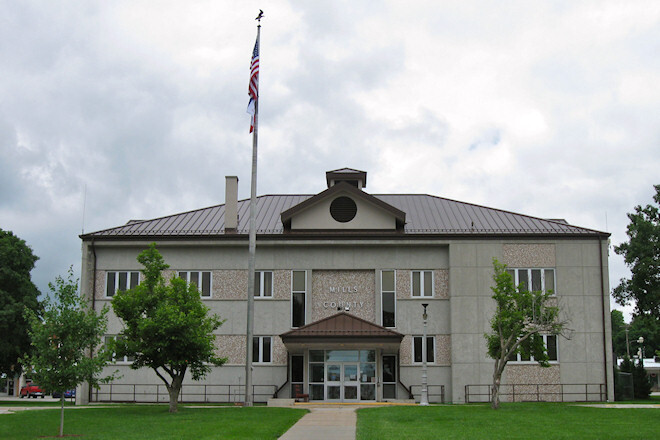Since the founding of our communities, organizations, businesses and citizens have stepped forward to build and serve their community. Click on any of the logos below to learn about those who made this website possible! If you would like to learn about becoming a sponsor CLICK HERE!
Mills County, IA
County in Southwest IAMills County, organized and established in 1851, was named for a young officer from Burlington, Iowa. Frederick Mills, a Yale graduate and lawyer, was enlisted and commissioned as an officer during the Mexican War from 1846-1848. He was killed August 20, 1847, leading a charge after General Santa Ana in the Battle of Cherubusco. In 1851, Mills County was named in memory of this hero.
The first settlement was called Rushville by the Mormons who arrived in 1846. Coonsville, named after Dr. Liberius Coons, a Mormon, first doctor and founder of the community, was changed to present-day Glenwood in 1853.
The first courthouse was a small 12' x 20' frame building which was replaced in 1857 by a two-story Georgian Colonial style building. An addition was made sometime after 1900 followed by the addition of a clock tower in 1910. This first courthouse served as home to the first newspaper in Mills County as well as a temporary barracks for Civil War troops in 1861. In 1898, an Iowa company was organized in the courthouse to serve in the war with Spain. This courthouse continued to serve its community well for the next 100 years. In 1959, it was replaced with the current, more modern building. The building was dedicated on August 29, 1959, amidst much fanfare.
Geographically, Mills county is located very near to the extreme Southwest corner of Iowa. It is bordered on the North by Pottawattamie County, on the East by Montgomery County, on the South by Fremont County, and on the West by the Missouri River. It is primarily an agricultural area. Many residents, however, work in industries in nearby Council Bluffs, Iowa and Omaha, Nebraska. Mills County boasts a variety of historical sites including a museum located in Glenwood which showcases many tools, implements, and household items of early life in the county as well as many Indian artifacts. The community of Tabor, which lies partly in Mills County, is the location of a once important station on the Underground Railroad as well as the home of Rev. John Todd who harbored the abolitionist, John Brown. The Todd house is preserved and now serves as a museum. Pacific Junction in the Western part of the county is the Junction for the Burlington Railroad lines from Denver to Chicago and Kansas City to Council Bluffs.
In addition, Glenwood is the site of the Glenwood State Hospital- School, the state operated home and school for the mentally handicapped. Started as a Soldier's Orphan's Home in 1866, it was closed in 1876 and the General Assembly converted the orphanage into the Asylum for Feeble Minded Children. Later renamed the Glenwood State Hospital-School, this became an important part of the lives of the inhabitants.
The 2010 census shows Mills county with an area of 437.44 square miles and a population of 15,059.
Alerts
County Residents Asked To Report Storm Damage
Have you received property damage from storms or other events? If so we'd like to know about it. Click Here to report your damage to us.

- County: Mills County, IA
- Region: Southwest IA
Destination Mills County, IA
- Sponsors
- Towns
- Businesses
- Community Organizations
- Faith Organizations
- Festivals and Events
- Points of Interest
- Veterans
Learn how to contribute to any of the above categories.
Towns of Mills County, IA
The small towns of the Midwest are rich in history and a great way of life! Below you can visit and learn about the small towns we call home! Towns that have their name highlighted have become FEATURED TOWNS. Businesses/organizations from these towns have stepped forward as SPONSORS enabling us to include (or will include as acquired) stories and website links to ALL their community organizations (chambers, groups and departments, etc.), stories and website links to ALL their points of interest, annual festivals/events and stories done about their citizens, veterans and faith community. To learn how to become a featured town CLICK HERE!








